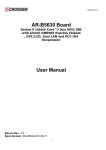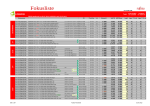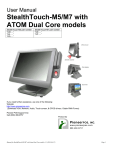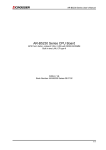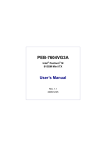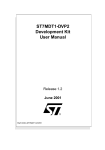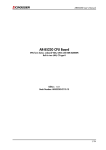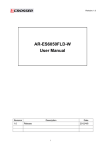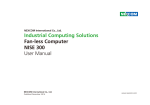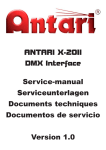Download AR-B5403 Board User Manual
Transcript
Revision: 1.0 AR-B5403 Board Socket P Intel® Core™2 Duo EPIC SBC with Intel® 945GM Express Chipset, Built in two LAN, CF type-II User Manual Manual Rev.: 1.0 Book Number: AR-B5403-2010.09.03 1 Revision: 1.0 Revision Version 1.0 Date Author 2010/09/03 Cody Description Initial release 2 Revision: 1.0 Copyright 2010 All Rights Reserved. Manual’s first edition: Sept, 02, 2010 For the purpose of improving reliability, design and function, the information in this document is subject to change without prior notice and does not represent a commitment on the part of the manufacturer. In no event will the manufacturer be liable for direct, indirect, special, incidental, or consequential damages arising out of the use or inability to use the product or documentation, even if advised of the possibility of such damages. This document contains proprietary information protected by copyright. All rights are reserved. No part of this Manual may be reproduced by any mechanical, electronic, or other means in any form without prior written permission of the manufacturer. Trademarks AR-B5403 is a registered trademarks of Acrosser; IBM PC is a registered trademark of the International Business Machines Corporation; Pentium is a registered trademark of Intel Technologies Inc; Award is a registered trademark of Award Software International Inc; other product names mentioned herein are used for identification purposes only and may be trademarks and/or registered trademarks of their respective companies. 3 Revision: 1.0 Table of Contents 1 Introduction .......................................................................................... 5 1.1 Features......................................................................................................... 5 1.2 Package Contents ......................................................................................... 7 1.3 Block Diagram ............................................................................................... 8 2 H/W Information.................................................................................... 9 2.1 Locations ....................................................................................................... 9 2.2 Connector and Jumper Setting Table ........................................................ 12 3 BIOS Setting ....................................................................................... 20 3.1 Main Setup ................................................................................................... 21 3.2 Advanced Chipset Setup ............................................................................ 22 3.3 PnP/PCI Setup ............................................................................................. 23 3.4 Peripherals Setup........................................................................................ 24 3.5 PC Health Setup .......................................................................................... 25 3.6 Boot Setup ................................................................................................... 26 3.7 Exit Setup .................................................................................................... 27 4 Revision: 1.0 1 INTRODUCTION Welcome to the AR-B5403 Computer. The AR-B5403 is an Intel Core 2 Duo EPIC single board computer provides variety of display outputs. In addition to VGA, DVI and LVDS display outputs, AR-B5403 supports S-Video, BNC, and component TV outputs. 1.1 Features Processor: Core 2 Duo, Core Duo and Celeron M Chipsets: 945GM + ICH7M Memory: DDR2 533/667MHz SO-DIMM, Maximum 2GB Display: VGA, DVI, LVDS, TV Out Storage: 1x CF, 2x SATA II, Audio: Line-out, Mic-in Communication: 2x Gbps Ethernet, 7x USB 2.0, 3x RS-232, 1x RS-232/422/485 General: Watchdog timer, 8-bit GPIO, and PCI-104 expansion slot. Specifications System CPU Chipset FSB Memory Video Graphic Controller Video Memory Video Interface Storage SATA CF Disk Bay I/O Ethernet Serial Port Support Intel Core 2 Duo/Core Duo/Core Solo/Celeron M CPU T7400 / T5500 / T2500 / CM440 CPU: L7400 Intel 945GME+ICH7M 533/667MHz One SO-DIMM socket support 667/533 MHz DDR2 SDRAM up to 2GB 1G Bytes 667MHz DDRII pre-installed Intel 945GME integrated GMA 950 graphic controller DVMT 3.0, Maximum 256MB shared 1 x VGA port (DB15) 2 x SATA II port, 1 x External Compact Flash Type I/II socket 1 x Anti-shock 2.5" HDD bracket swappable without open case 2 x Gbps RJ45 with LED, Broadcom BCM5787 4 x RS-232 5 Revision: 1.0 (2 x DB9, 2 x pin header, COM3 for reserve for PIC on power circuit, COM4 for GPS USB 7 x USB2.0 (4 x external port, 3 x pin header) GPIO 4-bit GPIO (2 In, 2 Out) with 5 pin terminal block, 2-in/GND/2-out Audio IC: Realtek ALC655 Interface : MIC-In, SPK-Out Remote control 1 x Remote control Fuse 7.5A Antenna Hole 1 x SMA for GPS, 1 x SMA for 3.5G, 1 x SMA for WiFi+Bluetooth miniPCIe 1 x miniPCIe option for MC8790 SIM SIM slot x1, SIM card changeable without opening case, latch to protect SIM uncertainly touch Expansion PCI-104 Keep design, remove PCI-104 slot Others GPS(option) Globalsat ER-332 3.5G(option) Sierra MC 8790/8790V, through miniPCIe slot on AR-B5403 WiFi(option) (1)2 in 1 module (WLBT-Combo-E), (2) Bluetooth 2 in 1 module (WLBT-Combo-E) Software OS support Windows XP/ XP embedded, Linux FC 6 /7 Power Power onboard design(AR-B5403) Wide range input DC 9V~32V Fuse Design Smart ATX power function: a. Power on/off retry b. Adjustable delay time for system OFF by Switch on power module (Mode2~Mode7) c. System on/off by Vehicle ignition or Remote switch button d. Low Power input monitoring, Auto shutdown S/W configurable by COM3 Remote switch(audio jack) System status LED(blue) Embedded power local switch AR-PW0932V default is Mode 2 Mechanical & Environment Thermal Design Heat pipe solution Chassis Metal steel Material Bracket Bracket with anti-thief function (Locker option) Dimension T.B.D. Vibration IEC 60068-2-64 5~500Hz, 3GRMS for SSD/CF, 1GRMS for 2.5”HDD, operating Shock IEC 60068-2-27 50G-500m/s -11ms, operating Operating -15~50℃ with Industrial Grade CF or SSD Temp. Storage Temp. -40~80℃ Certification CE/FCC class B 6 Revision: 1.0 1.2 Package Contents Check if the following items are included in the package. Quick Manual AR-B5403 board 1 x Software Utility CD 7 Revision: 1.0 1.3 Block Diagram 8 Revision: 1.0 2 H/W INFORMATION This chapter describes the installation of AR-B5403. At first, it shows the Function diagram and the layout of AR-B5403. It then describes the unpacking information which you should read carefully, as well as the jumper/switch settings for the AR-B5403 configuration. 2.1 Locations 2.1.1 Top Side CPU CPU Socket GMCH Graphic Memory Control Hub Intel 945GME ICH7M Graphic Memory Control Hub Intel GM45 USB Port and LAN 2 USB and 1 RJ-45 for LAN USB Port and LAN 2 USB and 1 RJ-45 for LAN Power LED and HDD LED Power LED and HDD LED Local Switch 12V Power Switch Status LED Machine Status LED GPIO Port Power Connector 12V Power Connector Remote Switch and Audio Remote Power Control and Audio I/O COM Port RS232 Serial Ports (COM1 & COM2) VGA VGA Port BIOS User Defined GPIO Port LAN Chip Broadcom BCM5787 Gigabit Ethernet BIOS IC SATA1 SATA Data Connector Mini-PCIE for 3G module 3G Module slot with USB interface SATA2 SATA Data Connector 9 Revision: 1.0 2.1.2 Bottom Side SO-DIMM Socket SO-DIMM Socket for DDR2 CF Slot CF Slot for CF Card support IDE Mode SIMM Card Socket SIMM Card Socket for 3G Module 10 Revision: 1.0 2.1.3 List of Connector and Jumper Setting PWR1 12V, 5V Output COM4 Pin Header for COM4 Port J6 CF Card Master setting J12 Connector for Programming PIC DVI3 DVI Output Port BAT1 Battery Input JP4 Define KEY_SW, ENG_STS input type FAN2 CPU FAN Connector CN2 3.5G Carrier Board Status LED CN10 Reserve Pin TVCON1 TV Output Port LCDPW1 Backlight Power and Control signal J11 Front Panel Connector J1 LVDS Panel Power Select LCD1 LCD Signal Output Fuse1 Fuse Connector CN8 +5V, +12V for External Module CON7 SATA Device Power SW1 DIP Switch for Power Mode Select J10 Jumper Select for GPIO Configuration JP1 COM2 Transfer Protocal setting FAN1 System Fan Connector USB2 Pin Header for USB Ports CON2 SATA Device Power IR1 IR Port USB3 Pin Header for USB Ports J5 COM2 RS-422,RS-485 Output CN9 +5V, +12V for External Module J9 Power SW, Reset, Buzzer Connector JBAT1 Pin Header for CMOS Clear 11 Revision: 1.0 2.2 Connector and Jumper Setting Table 1. PWR1 (12V,5V Output) 2. J12 (Connector for PIC Programming) PIN DEFINE PIN DEFINE 1 +12V 2 GND 3 4 GND +5V 1 2 3 4 5 +5VSB ISPDATA ISPCLK ISPVPP GND 4. CN10 (GPO reserve) 3. JP4 (Define Key_SW, ENG_STS Input Type) Status 5. J11(Front Panel Connector) (Note1) SIGNAL PIN Signal 1 GPO 2 GND 1 3 PWRBTN_IN LOC_SW 2 4 GND GND 5 KEY_SW 6 GND 7 ENG_STS 8 GND 9 STS_LED 10 GND PIN 7. SW1 (DIP switch for power mode select)(Note2) 1 2 3 4 0 ON ON ON ON 1 ON ON ON OFF 2 ON ON OFF ON 3 ON ON OFF OFF 4 ON OFF ON 5 6 ON ON OFF ON OFF OFF OFF ON 7 ON OFF OFF OFF ON PIN SIGNAL 1 GND 2 12V 3 FAN Speed Detect 12 Active High Short Active Low 6. FUSE1 (Connect to Fuse) PIN Signal 8. FAN1 (System FAN) Mode Open PIN Signal 1,2 Fuse Out 3,4 Fuse In 9. IR1 (IR Pin Header) PIN DEFINE 1 +5V 2 3 4 5 NC IR_RX GND IR_TX Revision: 1.0 10. J5 (COM2 RS-422,RS-485 Output) PIN SIGNAL 1 TX+ 11. J9 (Power Button & Reset & Buzzer) 12. COM4 (Pin Header for COM4) ※PWRBTN for ATX mode only PIN SIGNAL 2 TX- 3 RX+ 4 RX- PIN SIGNAL 13. DVI3 (DVI Port) 14. PIN SIGNAL PIN 1 GND 2 TD0 3 TD0- 4 GND SIGNAL 1 DCD 2 DSR 1 5V 2 PCBEEP 3 RX 4 RTS 3 GND 4 RESET 5 TX 6 CTS 5 GND 6 PWRBTN 7 DTR 8 RI 9 GND 10 NC FAN2 (CPU Fan connector) 15. TVCON1 (TV Output Port) SIGNAL 5 TD1 6 TD1- 7 GND 8 TD2 9 TD2- 10 GND 11 TCK 12 TCK- 13 HPD 14 DDCCLK 15 VCC 16 DDCDATA 17 RED 18 GND 19 GREEN 20 GND 21 BLUE 22 GND 23 VSYNC 24 25 HSYNC 26 CRT DDCCLK CRT DDCDATA PIN Signal PIN SIGNAL 1 1 GND 3 S-Video Luminance GND 2 12V 5 CVBS FAN Speed Detect 7 3 16 J1 (LCD Panel Power Select) SETTING 17 CN8 (Power Connect for +12V and +5V) PIN DEFINE 1 +12V GND GND +5V 1-2 close +5V 2 2-3 close +3.3V 3 4 13 PIN Signal 2 Reserve 4 Reserve 6 NC GND 8 Reserve S-Video 9 10 GND Chrominance 11 GND 12 NC 13 STATUS PIN SIGNAL PIN NC 14 NC 18 J10 (Jumper Select for GPIO configuration) PIN DEFINE 1-2 3-4 5-6 7-8 9-10 11-12 NC(DEFAULT) NO GND(DEFAULT) +5V +12V +EXT Revision: 1.0 19. USB2 (USB Output Port) PIN SIGNAL PIN SIGNAL 20. USB3 (USB Output Port) PIN SIGNAL PIN SIGNAL 21. CN9 (Power Connect for +12V and +5V ) PIN DEFINE 1 +5V 2 +5V 1 +5V 2 NC 1 +12V 3 DATA3- 4 DATA2- 3 DATA7- 4 NC 2 GND 5 DATA3+ 6 DATA2+ 5 DATA7+ 6 NC 7 GND 8 GND 7 GND 8 NC 3 4 GND +5V 9 GND 10 GND 9 GND 10 NC 22. JBAT1 (Pin Header for CMOS Clear) STATUS 23. J6 (CF Card status) 24. BAT1 (Battery Connector) SETTING STATUS SETTING 1-2 Normal SHORT Master 2-3 Clear CMOS OPEN Slave 14 PIN SIGNAL 1 VBAT 2 GND Revision: 1.0 25. CN2 (3.5G Module Status) PIN SIGNAL 1 +3.3V 2 Status Signal 28. CON7 (+12V,+5V,+3.3V for SATA HDD Power) PIN DEFINE 1 +12V 2 3 4 GND +3.3V +5V 26. LCDPW1 (Backlight Output) 27. LCD1 (LCD Signal Output) PIN DEFINE 1 +12V 2 +12V 3 4 5 6 GND Backlight Enable GND Backlight Control 29. JP1 (COM2 Type Setting) STATUS SETTING 1-2 RS-232 3-4 RS-422 5-6 RS-485 15 PIN SIGNAL PIN SIGNAL 1 3 5 7 9 11 13 15 17 19 21 23 25 27 29 LCDVCC B CLKGND B DATA2+ B DATA1NC B DATA0+ GND A CLKA DATA2+ I2C CLK A DATA1A DATA0+ NC LCDVCC 2 4 6 8 10 12 14 16 18 20 22 24 26 28 30 GND B CLK+ B DATA2GND B DATA1+ NC BDATA0A CLK+ GND A DATA2A DATA1+ I2C DATA A DATA0NC LCDVCC 30. CON2 (+12V,+5V,+3.3V for SATA HDD Power) PIN DEFINE 1 +12V 2 GND 3 4 +3.3V +5V Revision: 1.0 Note1,2 Power smart function Definition 1. Soft off cycle: A period when received power off signal to generate a off signal (A 500mS pulse, HighLow –High or Low-High-Low depends on SIO configuration, to mother board’s Power Button Pin) 2. Hard Off cycle: A period when system off (S5) to stand by removed (G3). In another word, the A period of 5VSB on to off (when system already off) Notes: S5 and G3 is follow by ACPI Mode description The main power-in is controlled by the switch on chassis. Maximum 16 Modes adjusted by 4 switches. (Mode 8 to mode 15 are reserved for future use). Mode 0: ATX mode. A. 5V Standby is always on. B. Input voltage is not monitored. C. Power on/off is controlled by remote switch D. Local Switch priority is higher than remote switch. This is controlled by hardware. Mode 1: AT mode A. Power output immediately after input is present. B. Power can only be turned off by turning off local switch. The remote switch will be ignored by Power smart function. In this mode the BIOS shall be set to AT mode. Smart Mode (Mode 2 to Mode 7) Mode 2: See Figure 1 A. Power on is controlled by ignition (remote switch does not make any action to power on). B. Power on retry: If the motherboard cannot be turned on normally (/PSON does not go to low), the Power smart function will turn off 5VSB, and then turn on 5VSB and retry. Send “on” pulse to motherboard again. The power board will re-try this procedure until successfully turn on motherboard. C. Power smart function sends “ON” pulse to motherboard when ignition is on for more than 2 seconds. D. Power smart function will ignore the status change of ignition after ON pulse is send to motherboard for 3 minutes. After this period, the Power smart function will start to check its status. This can avoid an improper “OFF” process before the OS is complete booted. E. Power off is controlled by remote switch or ignition. Remote switch has higher priority than ignition. (Remote switch is optional). F. Power smart function sends “off” pulse to motherboard 5 seconds after ignition is turned off or remote switch is pressed. (Soft delay) G. Power smart function will ignore the status change of ignition and remote switch during the “OFF” pulse is sent out and the /PSON return to high. This will avoid an improper ON process before the motherboard is completely shot off. 16 Revision: 1.0 H. The digital output (optional) will go from high to low at the moment that “OFF” pulse is sent to motherboard. The low state will be kept until /PSON back to high. If the /PSON does not back to high within 3 minutes, the Power smart function will enter a retry cycle (described in next section). I. Power off retry: If the motherboard cannot be shouted down normally (/PSON does not go to high) within 3 minutes after “OFF” pulse is sent, the Power smart function will send off pulse to motherboard again. If the motherboard still cannot be shouted down normally, the power output will be turned off directly. (Figure 3) J. Hard off delay: 1 minutes, During this period system can be turned on again if the off procedure already finished and power button is pushed again(or ignition on again) Mode 3: A. Same as mode 2 except for soft/hard off delay time B. Soft off delay: 1 minute C.Hard off delay: 5 minutes Mode 4: A. Same as mode 2 except for soft/hard off delay time B. Soft off delay: 30 minute C.Hard off delay: 2 Hours Mode 5: See Figure 2 Same as mode 2 except that the power on is controlled by remote switch. A. Power on is controlled by remote switch (ignition must be turned on 2 seconds before remote switch is pressed). B. AR-PW0932V sends off pulse to motherboard 5 seconds after ignition is turned off or remote switch is pressed. (Soft delay) C.Hard off delay: 1 minutes Mode 6: A. Same as mode 5 except for soft/hard off and delay B. Soft off delay: 1 minute C.Hard off delay: 5 minutes Mode 7: A. Same as mode 5 except for soft/hard off and delay B. Soft off delay: 30 minute C.Hard off delay: 2 Hours Mode15(Software control mode): A. Setting by AP B. Software mode default as Hardware mode 2 C. Soft off delay time can be set D. Hard off delay time can be set E. In-Vehicle system power on by ignition or Remote button can be set 17 Revision: 1.0 F. Show Ignition status / Voltage(for AP only) Engine status G. Create a button "Set default" Car Battery System on by Ignition Remote Switch Soft off delay time seconds Hard off delay time seconds Set Default Plan AP screen OK Cancel Table 1. Control Mode Mode 0 (ATX) 1(AT) 2 3 4 5 6 7 15 (Software control) Soft OFF Delay No No 5 seconds 1 minute 30 minutes 5 seconds 1 minute 30 minutes By user setting Hard OFF delay No No 1 minute 5 minutes 2 hours 1 minute 5 minutes 2 hours By user setting Power ON Control Power OFF Control Remote Switch Local Switch Ignition Ignition Ignition Remote Switch Remote Switch Remote Switch By user setting Remote Switch Local Switch Ignition / Remote Switch Ignition / Remote Switch Ignition / Remote Switch Ignition / Remote Switch Ignition / Remote Switch Ignition / Remote Switch Ignition / Remote Switch Another function of Smart Mode 1. If ignition turns back “ON” during “Off” Delay, Power smart function will stay in operation. “Off” signal will not be send to motherboard. The “Off” Delay will re-start after next ignition off. 2. Power input monitoring(before system boot on, during runtime, during soft off delay): The Power smart function will constantly monitor the input voltage. If the input voltage is below X Voltage (the standard might have 5% tolerance), the AR-PW0932V will not start the power on procedure. When Power smart function has ran in operation and the battery drops below Y Voltage (with 5% tolerance) more than 10 seconds the Power smart function will shut down the motherboard following the standard shut down procedure. If the input voltage recovers in 18 Revision: 1.0 10 seconds over Y Voltage (with 5% tolerance) again, the Power smart function will continue to run. (Figure 4)if this happens, ignition shall be off and on again (Mode 2, 3, 4) or press the remote switch(Mode 5,6,7) if you want to turn on system again. X value Y value For 12V car battery 11.2 10.8 19 For 24V car battery 23 22.5 Revision: 1.0 3 BIOS SETTING This chapter describes the BIOS menu displays and explains how to perform common tasks needed to get the system up and running. It also gives detailed explanation of the elements found in each of the BIOS menus. The following topics are covered: Main Setup Advanced Chipset Setup PnP/PCI Setup Peripherals Setup PC Health Setup Boot Setup Exit Setup Once you enter the Award BIOS™ CMOS Setup Utility, the Main Menu will appear on the screen. Use the arrow keys to highlight the item and then use the <Pg Up> <Pg Dn> keys to select the value you want in each item. 20 Revision: 1.0 3.1 Main Setup The <Main Setup> choice allows you to record some basic hardware configuration in your computer system and set the system clock and error handling. If the motherboard is already installed in a working system, you will not need to select this option. You will need to run this Setup option, however, if you change your system hardware configuration, the onboard battery fails, or the configuration stored in the COMS memory was lost or damaged. Note: Listed at the bottom of the menu are the control keys. If you need any help with the item fields, you can press the <F1> key, and it will display the relevant information. Option Choice Description Date Setup N/A Set the system date. Note that the ‘Day’ automatically changes when you set the date Time Setup N/A Set the system time IDE Channel 0 Master/Slave N/A The onboard PCI IDE connectors provide 1 channel for connecting up to 2 IDE hard disks or other devices. The first is the “Master” and the second is “Slave”, BIOS will auto-detect the IDE type. Halt On All Errors, No Errors, All but keyboard. Select the situation in which you want the BIOS to stop the POST process and notify you. 21 Revision: 1.0 3.2 Advanced Chipset Setup This section allows you to configure and improve your system and follows you to set up some system features according to your preference. Option Choice Quick Power On Self Test Enabled Disabled This category speeds up Power On Self Test (POST) after you have powered up the computer. If it is set to Enable, BIOS will shorten or skip some check items during POST. Full Screen Logo Show Enabled Disabled Select Edabled to show the OEM full screen logo if you have add-in BIOS. USB Keyboard Support Enabled Disabled Select Enabled if you system contains a Universal Serial Bus (USB)controller and you have a USB keyboard. On-Chip Frame Buffer Size 1Mb 8Mb Boot Display Panel Type DVWT mode DVWT/FIXED Memory Size CRT LCD CRT+LCD TV 800x600, 1024x768, 1280x1024 FIXED DVMT Both 64Mb 128Mb Description This Item is for setting the Frame Buffer (Share system memory as display memory). This Item is to set display device TV function only support on AR-B5230SD This Item cab Set the LVDS panel resolution that you want This item sets the mode for dynamic video memory thechology (DVMT). This item sets the DVMT size 22 Revision: 1.0 3.3 PnP/PCI Setup The option configures the PCI bus system. All PCI bus system on the system use INT#, thus all installed PCI cards must be set to this value. Option Choice Description Enabled Disabled Normally, you leave this field Disabled. Select Enabled to reset Extended System Configuration Data (ESCD) when you exit Setup. If you have installed a new add-on and the system reconfiguration has caused such a serious conflict, then the operating system cannot boot. Resources Controlled By Auto(ESCD) Manual The Award Plug and Play BIOS has the capacity to automatically configure all of the boot and Plug and Play compatible devices. However, this capability means absolutely nothing unless you are using a Plug and Play operating system such as Windows 95. If you set this field to “manual,” then you may choose specific resources by going into each of the submenus. IRQ Resources N/A Reset Configuration Data When resources are controlled manually, assign a type to each system interrupt, depending on the type of the device that uses the interrupt 23 Revision: 1.0 3.4 Peripherals Setup This option controls the configuration of the board’s chipset. Control keys for this screen are the same as for the previous screen. Option Onboard Serial Port 1 Onboard Serial Port 2 Onboard Serial Port 3 Onboard Serial Port 4 Choice Serial Port 1: 3F8 / IRQ4 Serial Port 2: 2F8 / IRQ3 Serial Port 3: 3E8 / IRQ11 Serial Port 4: 2E8 / IRQ10 Description USB Controller Enabled Disabled Select Enabled if your system contains a Universal Serial Bue (USB)controller and you have USB peripherals USB 2.0 Controller Enabled Disabled Select Enabled if your system contains a Universal Serial Bue (USB) 2.0 controller and you have USB peripherals AC97 Auido Function Enabled Disabled Audio/Modem On chip IDE DEVICE Enabled Disabled Select an address and the corresponding interrupt for each serial port. This item allows you to decide to enable/disable AC97 Audio The integrated peripheral controller contains an IDE interface with support for two IDE channels. Select Enabled to activate each channel separately. 24 Revision: 1.0 3.5 PC Health Setup This section shows the parameters in determining the PC Health Status. These parameters include temperatures, fan speeds, and voltages. 25 Revision: 1.0 3.6 Boot Setup This section is used to exit the BIOS main menu. After making your changes, you can either save them or exit the BIOS menu and without saving the new values. Option First / Second / Third Boot Device/Other Boot Device Choice Hard Disk CDROM USB-FDD USB-CDROM LAN Disabled LAN Boot Select Enabled Disabled Hard Disk Boot Priority N/A Description The BIOS attempts to load the operating system from the devices in the sequence selected in these items. These fields allow the system to search for an OS from LAN These fields set the Boot Priority for each Hard Disk 26 Revision: 1.0 3.7 Exit Setup This section is used to configure exit mode. Option Choice Description Pressing <Enter> on this item for confirmation: Save & Exit Setup Save to CMOS and EXIT (Y/N)? Y Load Optimized Defaults When you press <Enter> on this item you get a confirmation dialog box with a message like this: Press “Y” to store the selections made in the menus in CMOS – a special section of memory that stays on after you turn your system off. The next time you boot your computer, the BIOS configures your system according to the Setup selections stored in CMOS. After saving the values the system is restarted again Press ‘Y’ to load the default values that are factory-set for optimal-performance system operations. Load Optimized Defaults (Y/N)? N Exit Without Saving Pressing <Enter> on this item for confirmation: This allows you to exit Setup without storing any changes in CMOS. The previous selections remain in effect. This shall exit Quit without saving (Y/N)? Y the Setup utility and restart your computer. 27 Revision: 1.0 When a password has been enabled, you will be prompted to enter your password every time you try to enter Setup. This prevents unauthorized persons from changing any part of your system configuration. Set Password Pressing <Enter> on this item for confirmation: ENTER PASSWORD: Type the password, up to eight characters in length, and press <Enter>. The password typed now will clear any previous password from the CMOS memory. You will be asked to confirm the password. Type the password again and press <Enter>. You may also press <Esc> to abort the selection and not enter a password. To disable a password, just press <Enter> when you are prompted to enter the password. A message will confirm that the password will be disabled. Once the password is disabled, the system will boot and you can enter Setup freely. 28




























